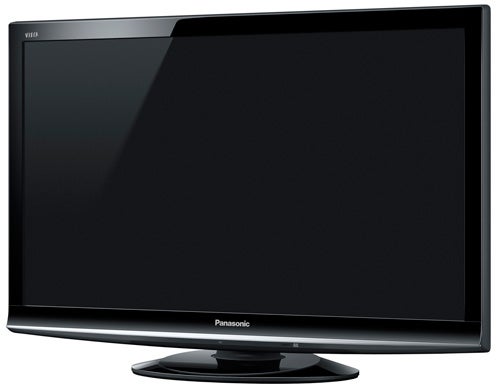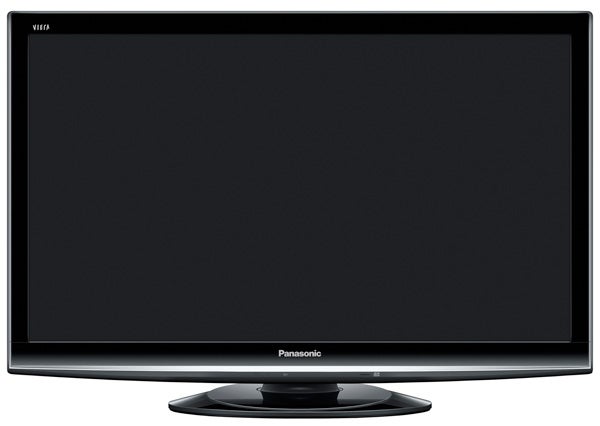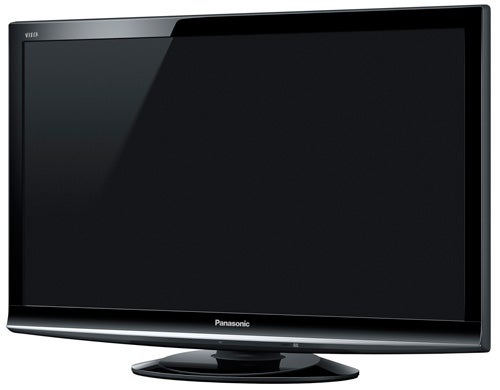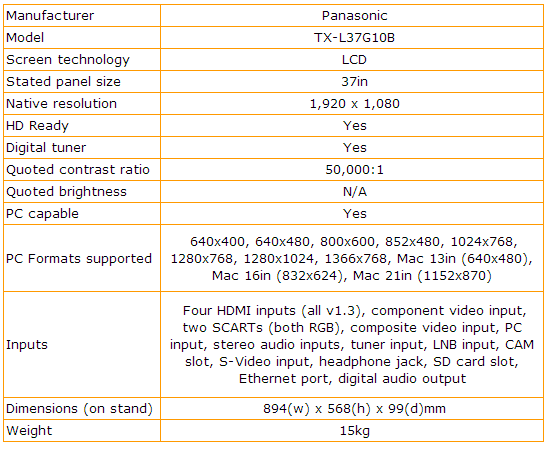Panasonic Viera TX-L37G10 37in LCD TV Review
Panasonic Viera TX-L37G10 37in LCD TV
With an IPS panel, Freesat HD tuner and the latest Intelligent Frame Creation system, what's the L37G10 like?

Verdict
Key Specifications
- Review Price: £1049.99
After making a solid arrival with a couple of recently reviewed low-end ‘X10′ models, Panasonic’s latest – and most expansive – TV range kicks up a gear today with the TX-L37G10B. This is a much more mid-range offering, upping the feature count in two particularly significant ways: the addition of a built-in Freesat HD tuner, and the addition of Panasonic’s latest Intelligent Frame Creation system.
More on these presently. But first it’s a relief, too, to find the L37G10 also marking a significant step forward for Panasonic aesthetically. Regular readers will know that it’s been an age since I was really enthused by a Panasonic TV design, yet while the L37G10 is hardly a supermodel, the slimness of its bezel and the neat compactness of its desktop stand and bottom edge do at least make it look kinda cool in a macho kind of way.
The set also goes much further with its connections. The HDMI count rises to four from the X10 range’s three, while the provided SD card slot can play back video files as well as the JPEG image files supported by the X10 models. Plus, of course, there’s a connection for the feed from your Freesat satellite dish LNB alongside the usual RF tuner input, and an Ethernet port for future online Freesat-related services. 
None of these potential services are available yet, but at least with this new generation of Freesat TV Panasonic has made the effort to discuss in the manual how to get the TV talking to your broadband connection via your router. And if you’re interested, the exact wording Panasonic uses in the manual to describe the Ethernet’s operation reads like this: “Network settings are for applications from broadcasters to enable greater interactivity and added features for Freesat services.”
What’s encouraging about this sentence is the clear implication that the sort of online services available might ultimately be much more extensive than just the BBC iPlayer support we’ve been guessing at since we first noticed Ethernet ports on Freesat TVs. Watch this space.
While we’re on the subject of the L37G10’s Freesat functionality, let’s briefly cover off the TV’s Freesat electronic programme guide support. Happily, the first thing that comes up when you press the dedicated Guide button on the remote is a list of genres, enabling you to immediately filter out a lot of unwanted channels from your search before you proceed to the listings section proper.
This listings section is clearly presented, and features a simpler layout and better use of the coloured buttons on the remote than we found with LG’s recent Freesat debutante. The L37G10’s listings also scroll around faster than the slightly sluggish ones of the LG TV.
In an ideal world Panasonic would have kept the picture running in a small box somewhere among the listings, but then I guess the world is seldom ideal, is it?!
Getting back to the improvements offered by the L37G10 over the LCD X10 model we’ve seen, the L37G10 enjoys a Full HD resolution rather than an HD Ready one. The L37G10’s quoted contrast ratio is a very respectable one, too, at 50,000:1.
It’s also important to stress in this part of the review that the L37G10 uses one of Panasonic’s IPS Alpha LCD panels. This means that you can watch it from a much wider angle than most LCD TVs without colours losing saturation. And I can tell you right away that this isn’t just marketing spin; it’s actually true!
The IPS Alpha panel in conjunction with Panasonic’s latest V-Real processing engine (Pro 4), meanwhile, also allows the L37G10 to deliver a claimed 800 lines of motion resolution.
Heading into the TV’s clear and reasonably concise onscreen menus uncovers one or two other interesting little tidbits. First, there’s a series of picture presets, joined by an automatic colour management system, an Eco mode that adjusts the picture in response to the amount of light in your room, and multi-level picture noise reduction.
There’s also, tucked away sneakily within an otherwise unremarkable ‘Other Settings’ sub-menu, the set’s Intelligent Frame Creation options. IFC, as its name suggests, uses high-spec processing to introduce extra frames of picture information, so that motion can look both less blurred and more fluid than usual with an LCD TV.
The options available for IFC comprise turning the feature off completely, setting it to a mid level, or whacking it all the way up to High. Intriguingly, if you head for the IFC menu while watching a Blu-ray set to 1080p/24 output, it magically transforms into a similar ‘24p film mode’, with the same off, mid and high settings.
Since we’re on the subject of all this motion processing, we might as well start an analysis of the L37G10’s picture quality by looking at just how the different IFC/24p options stack up.
The first thing I’d say is that using the IFC or 24p film mode on the High setting is for the most part not a good idea. It works well enough with relatively static footage, removing pretty much all trace of judder and leaving motion looking noticeably clearer. But when it’s pushed hard by a sudden fast movement, or a large amount of movement across the whole frame, you can clearly see subtle flickering interference over some of the motion, or subtle shimmering halos around the edges of the moving objects.
Although these artefacts seem much less obvious than they have been on previous Panasonic IFC systems, when they occur, they’re still jarring.
The Mid setting is a much more consistent, ‘gentle’ and therefore usable option. There are far fewer obvious artefacts to contend with, leaving you much freer to become fully embroiled in what you’re watching.
Inevitably there’s a price to pay in terms of motion that looks both slightly less crisp and less fluid than it does using the High setting. And occasionally glitches can still be seen. But for me this mid setting’s advantages outweighed the negatives comfortably enough to make it the setting I personally would leave on for the majority of the time.
Although it perhaps sounds a bit daft given that it’s a key selling point of the TV, turning the IFC/24p Film Mode off completely is worth experimenting with. For while the increase in judder you’ll experience is considerable, especially during fast camera pans, the effect of the judder is arguably less distracting during high-octane action films or sports footage than the potential for processing artefacts if you put the IFC/24p Film mode on.
The bottom line with all this is that while no IFC/Film mode setting can deliver perfect pictures, the flexibility Panasonic provides with it means you can get good results for nearly all of the time.
Turning now to more general aspects of the picture, there are clear signs of improvement over the slightly disappointing efforts of the X10 model we’ve seen.
The most striking of these improvements, to my eyes, comes with the set’s colour response. The picture is generally impressively bright, and this helps colours drive off the screen with plenty of dynamism. But crucially, as well as being brighter, colours are more inclined to enjoy natural, believable tones. 
There seems to be greater subtlety in the L37G10’s colour blending too, presumably due at least in part to the screen’s extra resolution. And this has a particularly happy effect on standard definition skin tones, which look even less waxy and patchy than they did on the 32X10. There’s evidence here, too, of just how stable and refined the L37G10’s Freesat receiver/decoder is.
The enhanced richness and tonal subtlety of the L37G10’s colours has yet another positive impact, too. For it helps pictures look strikingly solid and three dimensional, especially – though not exclusively – when watching HD footage.
Of course, all the colour richness in the world won’t achieve a truly solid-looking picture if not supported by a convincing black colour as a counterpoint for all the nice, bright, colourful stuff. So thankfully, the L37G10’s black level response is respectable enough to help normal TV pictures look punchy and involving.
More good news comes from the consistency of the L37G10’s backlight, which seems even across the whole screen rather than suffering the minor ‘pooling’ problems witnessed on its cheaper 32X10 sibling.
Finally, in the plus column, HD pictures really do look very sharp, with the set effortlessly reproducing, for instance, the deliberate graininess of the opening black and white sequence of ”Casino Royale” on Blu-ray.
For all the L37G10’s strengths – strengths which at times make its pictures look quite spectacular – the picture quality score registered at the top of this review is only an eight. And the main reason for this is that while good, the L37G10’s black level response isn’t totally great. Dark picture areas certainly look greyer and thus less natural and flatter than they do on, say, any LED TVs. Or, more pertinently, the Samsung LE40B651 LCD TV we looked at last week, or Panasonic’s own plasma TVs. 
Finishing up with the L37G10’s sound, the news is… average. Bass sounds slightly forced and shallow, while the mid-range can become overwhelmed when the going gets tough, with the result that voices can sound swallowed. Trebles are the TV’s strength, as high-pitched effects sparkle and add life to the mix while only very occasionally sounding slightly harsh.
Overall, you’ve got the common flat TV situation whereby the L37G10 sounds fine with all normal day-to-day TV viewing, but struggles to meet the challenge of a potent action scene.
”’Verdict”’
The L37G10 may not be a perfect TV, but it’s certainly a very good one. Particularly pertinently, it marks a big improvement over Panasonic’s previous Freesat LCDs – and we suspect this fact could be enough by itself to win it a very tidy following.

How we test televisions
We test every TV we review thoroughly over an extended period of time. We use industry standard tests to compare features properly. We’ll always tell you what we find. We never, ever, accept money to review a product.
Trusted Score
Score in detail
-
Features 8
-
Value 7
-
Image Quality 8
-
Design 8
-
Sound Quality 7
Features
| Size (Inch) | 37in |
| Display Type | LCD |

